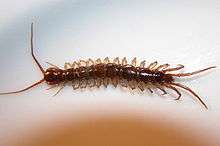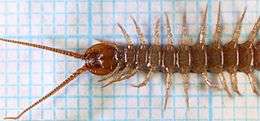Lithobius forficatus
| Lithobius forficatus | |
|---|---|
 | |
| Scientific classification | |
| Kingdom: | Animalia |
| Phylum: | Arthropoda |
| Subphylum: | Myriapoda |
| Class: | Chilopoda |
| Order: | Lithobiomorpha |
| Family: | Lithobiidae |
| Genus: | Lithobius |
| Species: | L. forficatus |
| Binomial name | |
| Lithobius forficatus (Linnaeus, 1758) | |
Lithobius forficatus, most commonly known as the brown centipede or stone centipede, is a common European centipede of the family Lithobiidae, although its distribution is not exclusive to Europe. It is between 18 and 30 mm long and up to 4 mm broad and is a chestnut brown color.

It is similar to a variety of other European lithobiid centipedes, particularly the striped centipede, Lithobius variegatus, but L. forficatus does not have stripes on its legs. Like most lithobiids, it is found in the upper layers of soil, particularly under rocks and rotting logs. This species can be fairly easily identified by its reaction to being revealed, which is to run extremely quickly for cover. This is different from many of the other species of large lithobiid, which tend to be less extreme in their evasion behavior.
Development
Lithobiid's leave the egg with 7 pairs of legs, they develop more legs along with a new body segment each time they molt.[1]
References
- ↑ Smithsonian: Animal The Definitive Visual Guide. New York, NY: DK Publishing. 2011. p. 578. ISBN 9780756686772.
External links
| Wikimedia Commons has media related to Lithobius forficatus. |
- Stuart M. Bennett (2000). "Lithobius forficatus". Retrieved 18 June 2006.